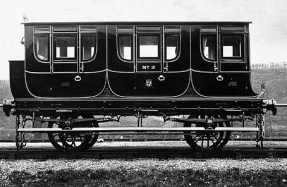

Lincolnshire was thoroughly ‘Beechinged’. Looking at a map of the county today we have the line from Cleethorpes and Grimsby just below the Humber in the north, which reaches Barnetby (Wrawby Junction) then heads off in three different directions like the hydra, towards Scunthorpe and Doncaster, Gainsborough and Retford, and Market Rasen and Newark. That lot was once all a part of the GC (Great Central) network. There are two rival lines that still head south from Doncaster, cutting across Lincolnshire on the way: the old GN (Great Northern) line which speeds through Newark and Grantham as part of today's ECML (East Coast Main Line); the old GN&GE Joint (Great Northern and Great Eastern Joint Railway) which takes in Gainsborough, Lincoln, Sleaford and Spalding on its rather more circuitous route to Peterborough. Finally, there's the line from Skegness via Boston which arrives at Sleaford, one remnant of the old GN lines to have survived.
That has left the county with a big hole, though, between the Grimsby line in the north and the Skegness line in the south just above the Wash. In the past there was a maze of GN lines that occupied this void. In the far north west of the county there was the LY&NE Joint (Lancashire & Yorkshire Railway & North Eastern Railway Joint) line which headed off from Haxey on the Gainsborough–Doncaster line, and up to Reedness Junction. from where lines diverged to Goole or Fockerby. The Midland Railway (MR) had a small presence in the county and whilst the line through Swinderby towards Nottingham has survived, that between Little Bytham on today's GEML and Leicester has not. Another line to lose out was the Midland & Great Northern Joint (M&GN Joint) which headed west from King's Lynn through Spalding and Bourne to arrive at the same Little Bytham. What's left is not much given that Lincolnshire is England's second-largest county and as my brief introduction confirms, there were no fewer than six railway companies with lines in Lincolnshire when the 1923 grouping simplified matters. A lot of the county's lines may have gone but the impact of the railways should never be underestimated: when Lincoln suffered a typhoid epidemic in 1904-05, which was to kill more than 130 people, fresh water was brought in by train, the precious commodity filling up rakes of old locomotive tenders.

Midland Railway
The first railway to arrive was the MR line between Nottingham and Lincoln (1846), a George Hudson ‘cunning plan’ to try and interfere with any plans that the London & York Railway (later Great Northern) might have had in the same locale. Engineered by Robert Stephenson, the line opened on 4th August 1846 and is today known as the ‘Castle Line’. The terminus was Lincoln St. Marks, which actually opened as ‘Lincoln’ before being renamed in 1950 and closed in 1985 when all services were diverted to Lincoln Central which is today's ‘Lincoln’. After St. Marks there were just three stations in Lincolnshire along this line at Hykeham, Thorpe-on-theHill and Swinderby of which just




